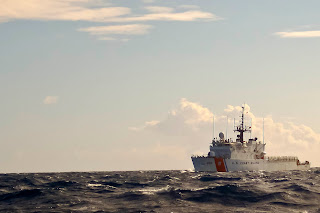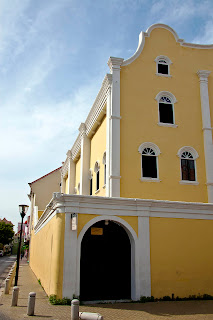It was great returning to Boqueron; enjoying Chuck’s company (we had met Chuck 2 years ago waiting for a bridge on the ICW -- another long story of how cruisers meet and re-meet); and embracing life in Puerto Rico. But Florida beckoned and we diligently studied weather and waited for the right time to go.
We had a wonderful surprise when son Jay decided to come with us for the passage. We flew him to Mayaguez, provisioned for an extra crew member, and left Boqueron on a calm, sunny Tuesday morning. We were more than halfway across the Mona Passage before the winds came up and the seas started tossing us around. Poor Jay suffered from a bout of seasickness that continued into the next day as we rounded the northern coast of the Dominican Republic. By day three, all crew was healthy and we established a routine of watchstanding overnight that allowed us to each get sufficient sleep. And John started an ambitious effort to provide real meals for dinner requiring great coordination and gymnastic ability. But a well-fed crew is a happy crew, so it was worth the effort.
Anhinga sailed incredibly well -- liking the points of sail west and NW -- with the autopilot managing all but the most gusty of winds and breaking seas. What a difference it makes to not have to steer all the time! We all had time to enjoy the beautiful sunny days and watch the sea. The extent of our wildlife encounters were flying fish and a few birds. And every morning we did the deck check to see how many fish we caught -- at least 5 flying fish a day -- that got thrown on deck by waves or didn’t see us coming and leaped to their deaths on board.
Passing the Caicos Bank and the Great Bahamas Bank significantly smoothed the waters and traveling the Old Bahama Channel, a terrific ride. Sailing north through the Santaren Channel we got a knot or two of lift from the current, but that was nothing compared to our ride on the Gulf Stream in the Straits of Florida. There, we were suddenly traveling consistently over 8 knots, then 9 knots, and popping 10s and 11s, with 11.4 knots the highest speed we noticed. Yee-hah!!!
Then on our last day at sea, Poseidon decided to remind us of his power. Patti went below to prepare and send an SSB sailmail message to our families to let them know we had Florida in our sights. John and Jay were in the cockpit enjoying the ride, when suddenly Jay’s eyes went wide as he stared behind John’s head and yelled, “big wave, big wave!!” The water suddenly crashed over the bimini knocking Anhinga about 60 degrees -- just for a few seconds -- before righting herself. Not a knockdown, thankfully, but darn close. No damage at all, even though all the glassware and pots and pans crashed around in the lockers. Within a minute we had taken stock and were merrily rolling along again, but wow -- we knew how quickly our luck could have changed.
After a week at sea we had only seen one other sailboat, a handful of cargo ships, fishing boats, and many cruise ships. Our favorite sightings were the US Coast Guard ships and helicopter. Starting south of the Bahamas, we saw the USCG four times as they patrolled the waters between Florida and Puerto Rico. The 270’ cutter Tahoma spent quality time tracking and talking with us as they turned our appearance in their operations area into an opportunity for some routine questioning.
By Monday evening we had rolled up the sails and were angling into the channel at Port Everglades in Fort Lauderdale. We felt like hicks come to the big city. The lights! The buildings! We were a little overwhelmed. We made it just in time through the first bridge opening at 17th Street and worked our way through the ICW up to Las Olas bridge. Once there we decided to put the anchor down for the night and wait till daylight to continue up to Delray Beach. Being in flat water for the first time in a week felt so strange. Not having to brace ourselves to move about was a novelty. All of us sleeping at the same time was also weird. It was also bittersweet, leaving the freedom of the ocean, and our time with the wind and the water.
Tuesday with Jay at the wheel, we puttered the rest of the way to Delray up the ICW. Our appreciation for the beauty of south Florida increased as we admired the mangroves, herons, pelicans, and iguanas as well as the incredible houses on the waterway. Twelve bridge openings later, we headed for the Delray Harbor Club Marina. It was so great to be back in Florida, our 1,000 mile journey ended.





























































